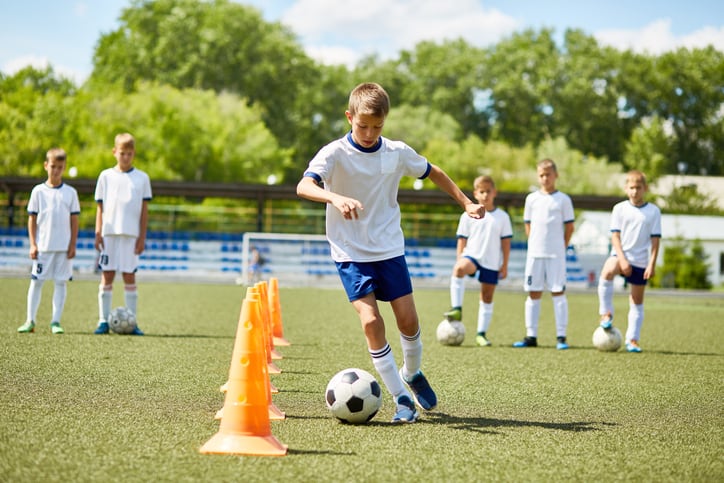A Parent’s Guide to Youth Sports: How to stay active, stay safe and put heart back into the game.
Nothing says America like Friday night lights. Or, depending on your child’s choice—cheers from soccer fields on Saturday morning, the thud of tennis balls on a sunny day at court, or the whack of a ball against a baseball bat in the warmth of a spring morning.
Dr. Sean Keyes, pediatric orthopedic surgeon at AdventHealth for Children, is an avid supporter of youth sports. He applauds athletics for teaching children about teamwork, sportsmanship, fitness and friendship.

In Case You’re Interested:
>> Super Fun Family Restaurants
>> Cheap Family Fun
>> Orlando Hotels with Waterparks
However, once a structured outlet for youthful energy, youth sports have become a $9 billion world industry, one that pushes children further than it ever has starting at a younger and younger age. To keep the joy in sports, Dr. Keyes cautions parents against creating an overly intense environment for young athletes that can cause them harm physically and mentally.
“It’s so competitive that we lose sight of the real goal of youth sports,” says Dr. Keyes. “Sports teaches kids to make friends, manage stress, how to handle conflict maturely, and how to win, lose and show good sportsmanship. We get so caught up in skills that we forget values.”
Here are six tips that can help keep the joy in sports for your young athlete:
1. Play Multiple Sports
“Single sports specialization is one of the biggest epidemics in pediatric orthopedics,” says Dr. Keyes, who sees countless baseball players with elbow injuries from pitching year-round, and female soccer players presenting with ACL tears as young as 6 years of age. Playing only one sport year-round puts immense strain on just one group of muscles. Playing multiple sports not only protects the body, but helps develop a physically, mentally, physiologically and emotionally well-rounded athlete. Some of the most successful athletes are good at multiple sports, Dr. Keyes points out.
2. Tailor intensity to the age of the child
Generally, girls don’t stop growing until they are 14, and boys until they are 16 or 17. Until then, their tendons, muscles and growth plates are still forming. Putting intense strain on one set of muscles can cause irreparable damage. Encourage an elementary or middle school child to stay active and play sports, but don’t force them to specialize until they are in high school. “We treat our kids like they are little professional athletes,” says Dr. Keyes. “But they are young. We have to protect them.” It’s also important to talk to and guide young athletes at a cognitively age-appropriate level. And if they do suffer injuries, take them to a doctor that specializes in pediatric orthopedic injuries because treatment is different than it is for adults.
3. Hydration: Water is still the best choice
Although a plethora of hydration and sports drinks have entered the market, Dr. Keyes points out that most of those drinks are high in sugar content and can lead young athletes to have sugar spikes and crashes. For the first two hours of intense exercise, they should drink water. Then, they can switch to sports drinks to replenish electrolytes. Caffeinated drinks are not recommended for student athletes.
4. Account for Florida heat when planning practice
With this year’s intense heat, some area schools have moved practice to very early mornings—even 5 a.m.—or have taken drills indoors. If the heat index is too high, Dr. Keyes suggests that coaches and clubs consider skipping practice, moving it indoors, or using the time for cross-training or related activities. If they will be playing outdoors, remind your young athlete to take plenty of water breaks and cool down by moving to the shade or splashing water on their heads occasionally.
5. Mix up practice
Training or coaching sessions and club sports can be expensive. Everyone wants to make the most out of practice time. This means that athletes often launch right into drills from the minute they walk into the session. Dr. Keyes suggests that parents and coaches ensure enough time for warm-ups, cool-downs, stretching and calisthenics, and more to practice than physical activities. Whether it’s through a team mantra, prayer or conversations, practice should also be a place for collegiality and collaboration.
6. Take at least three months off from sports each year
When seasons and camps are available to you 365 days a year, it can be difficult for parents not to feel like their child is falling behind if they aren’t constantly signed up for something. But time off from structured sports gives children time to heal, rest and diversify their interests. Even if they don’t take three months off in one stretch, encourage your child to take a month off after every three months or after each season. “Give your child some time to be a kid,” says Dr. Keyes.
Despite the injuries he treats, Dr. Keyes remains a staunch advocate of youth sports for children’s mental and physical development. His best advice for all kids? “When you are young is the time to find the physical activity you love. There’s a sport for everyone.”

